101 electrical wiring diagram pdf
An electrical wiring diagram is a graphical representation of an electrical circuit, using standardized symbols to illustrate components and their connections. It serves as a blueprint for understanding, installing, and troubleshooting electrical systems, essential for technicians and engineers to ensure safety and efficiency in system design and operation.
1.1 What is an Electrical Wiring Diagram?
An electrical wiring diagram is a visual representation of an electrical circuit’s components and connections. It uses standardized symbols to depict devices, wires, and their interconnections, providing a clear guide for installing, troubleshooting, and maintaining electrical systems. These diagrams are essential for electricians, technicians, and engineers to understand how power flows through a system and ensure safe and efficient operation. They are widely used in residential, commercial, and industrial settings to plan and execute electrical installations accurately.
1.2 Importance of Electrical Wiring Diagrams
Electrical wiring diagrams are crucial for ensuring safety, efficiency, and compliance with electrical standards. They provide a clear visual guide for installing, maintaining, and troubleshooting electrical systems, reducing the risk of errors and downtime. These diagrams are essential for electricians, engineers, and technicians to understand circuit connections, identify potential hazards, and plan modifications. They also facilitate communication among stakeholders, ensuring that electrical systems are designed and implemented correctly. Their importance spans industries, including automotive, construction, and electronics.

Components of an Electrical Wiring Diagram
An electrical wiring diagram consists of symbols, lines, and labels representing components like switches, outlets, and circuits. It includes wire colors, connections, and pathways, providing a detailed layout of the electrical system for installation, troubleshooting, and maintenance. These components ensure clarity and accuracy in understanding the circuit’s structure and function.
2.1 Symbols Used in Wiring Diagrams
Electrical wiring diagrams use standardized symbols to represent components such as switches, outlets, lights, and circuit breakers. These symbols, like circles for switches or rectangles for outlets, simplify the visualization of complex circuits. They ensure consistency across diagrams, making it easier for technicians to understand and work with the electrical system. Each symbol corresponds to a specific component, allowing for accurate identification and interpretation of the circuit’s structure and functionality. This standardization is crucial for safe and efficient electrical work.
2.2 Understanding Circuit Components
Electrical circuits consist of various components such as switches, outlets, lights, and circuit breakers. Each component plays a specific role in the system, with switches controlling power flow and circuit breakers protecting against overcurrent. Understanding these components is essential for interpreting wiring diagrams, as they are graphically represented to show their connections and functions. This knowledge enables technicians to identify how power is distributed and how safety mechanisms are integrated into the system, ensuring efficient and safe electrical operations.
2.3 Wire Colors and Their Meanings
Wire colors play a crucial role in electrical wiring diagrams, as they indicate specific functions and safety standards. Black wires typically carry power, while white wires are neutral. Copper or green wires are ground wires, ensuring safety by providing a path to earth. Red wires often denote secondary power sources, and yellow wires may indicate three-way switches. Understanding these color codes is vital for correctly interpreting wiring diagrams and ensuring safe electrical connections, as each color corresponds to a specific function and system requirement.
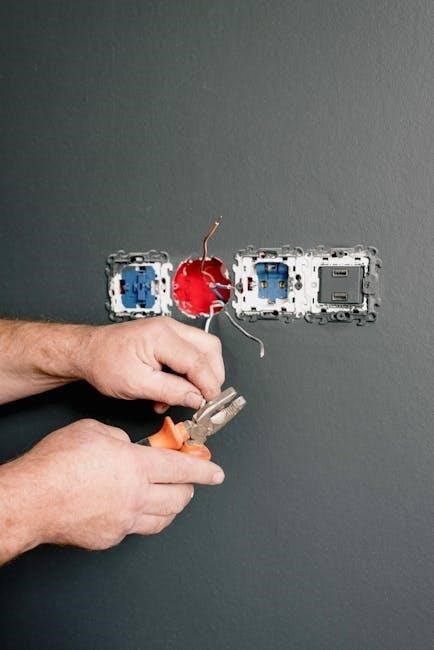
How to Read an Electrical Wiring Diagram
Reading an electrical wiring diagram involves identifying the power source, understanding switches and outlets, and interpreting circuit pathways. Start by locating the main power supply, then trace connections through switches and outlets to loads like lights or appliances. Use symbols and labels to identify components and ensure all pathways are logically connected, allowing for safe and efficient system operation.
3.1 Identifying the Power Source
In an electrical wiring diagram, the power source is typically represented as the starting point of the circuit, often denoted by a battery, AC supply, or incoming lines. It is crucial to identify the voltage rating (e.g., 120V or 230V) and ensure it matches the system’s requirements. The power source is usually connected to the main circuit breaker or fuse box, which distributes power to various components like switches, outlets, and appliances. Always verify the power source location and specifications to ensure safe and efficient system operation.
3.2 Understanding Switches and Outlets
Switches and outlets are essential components in electrical wiring diagrams, representing points of control and connection. Switches are typically marked with “S” or “SW” and are used to control the flow of power to lights or appliances. Outlets, denoted by “O” or “OUT,” provide connection points for devices. In diagrams, switches are often shown in series with loads, while outlets are parallel connections; Understanding their symbols and placement is crucial for proper installation, troubleshooting, and ensuring safe electrical connections in residential or commercial systems.
3.3 Interpreting Circuit Pathways
Circuit pathways in wiring diagrams show how electricity flows from the power source through components to complete the circuit; Lines represent wires, while symbols depict devices like switches, outlets, and bulbs. Arrows indicate current direction, and parallel lines show multiple pathways. By tracing these paths, technicians can identify how power is distributed, locate potential breaks, and ensure all components are correctly connected. This interpretation is vital for troubleshooting, installing, and maintaining electrical systems efficiently and safely.

Types of Electrical Wiring Diagrams
Wiring diagrams include schematic, wiring layout, and pictorial types. Schematic diagrams show electrical connections, wiring layouts depict physical arrangements, and pictorial diagrams use images for clarity, aiding various applications.
4.1 Schematic Diagrams
Schematic diagrams are detailed representations of electrical circuits, using standardized symbols for components like resistors, capacitors, and switches. They focus on the electrical connections and functions, simplifying complex systems into clear, abstract layouts. These diagrams are essential for engineers and technicians to design, analyze, and troubleshoot circuits efficiently. By prioritizing function over physical appearance, schematics enable easier understanding of how a system operates, making them indispensable in both educational and professional settings.
4.2 Wiring Layout Diagrams
Wiring layout diagrams provide a visual representation of the physical arrangement of wires and components in an electrical system. They detail the routing of wires, component locations, and connection points, making it easier to plan and execute installations. These diagrams are widely used in industries like automotive and construction for clarity and precision. They are often included in equipment manuals or service manuals, offering a practical guide for technicians. While detailed, wiring layout diagrams can span multiple pages for complex systems, ensuring comprehensive coverage of all connections and pathways.
4.3 Pictorial Diagrams
Pictorial diagrams use real-life images or illustrations of components to depict electrical connections, making them highly intuitive. They are commonly used in automotive and industrial systems to show the physical appearance of devices and their interconnections. Unlike schematic diagrams, pictorial diagrams focus on the visual representation of components, aiding technicians in identifying parts quickly. They are particularly useful for complex systems where a clear visual guide enhances understanding. These diagrams often complement other types, providing a holistic view of the electrical setup.
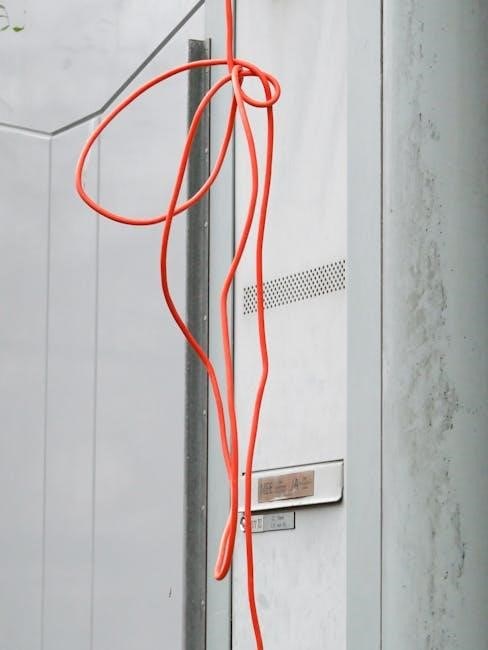
Applications of Electrical Wiring Diagrams
Electrical wiring diagrams are essential for various applications, including residential, commercial, and industrial wiring. They provide clear guidance for installing and troubleshooting electrical systems across these sectors.
5.1 Residential Wiring
Residential wiring diagrams are essential for understanding and installing electrical systems in homes. They outline connections for outlets, switches, and lighting fixtures, ensuring safe and efficient power distribution. These diagrams guide homeowners and electricians in troubleshooting common issues like circuit overloads or faulty connections. By following the diagram, one can identify the correct wire colors and their purposes, ensuring compliance with local electrical codes. This clarity aids in maintaining safety and functionality within a household’s electrical infrastructure, making it a vital tool for both installation and maintenance tasks.
5.2 Commercial Wiring
Commercial wiring diagrams are designed for larger, more complex electrical systems in offices, retail spaces, and industrial facilities. They detail the layout of circuits, outlets, and lighting systems tailored to higher power demands. These diagrams ensure compliance with commercial electrical codes and safety standards, while also supporting scalability for future upgrades. They are indispensable for electricians and contractors, providing clear guidance for installing, maintaining, and troubleshooting electrical systems in commercial environments to ensure reliability and efficiency.
5.3 Industrial Wiring
Industrial wiring diagrams are specialized for complex electrical systems in factories, plants, and manufacturing facilities. They detail high-voltage circuits, motor controls, and machinery connections, ensuring compliance with industrial safety standards like NFPA 79. These diagrams are crucial for installing, maintaining, and troubleshooting heavy-duty equipment and automated systems. They prioritize robustness, scalability, and safety, enabling efficient operation and minimizing downtime in demanding environments.
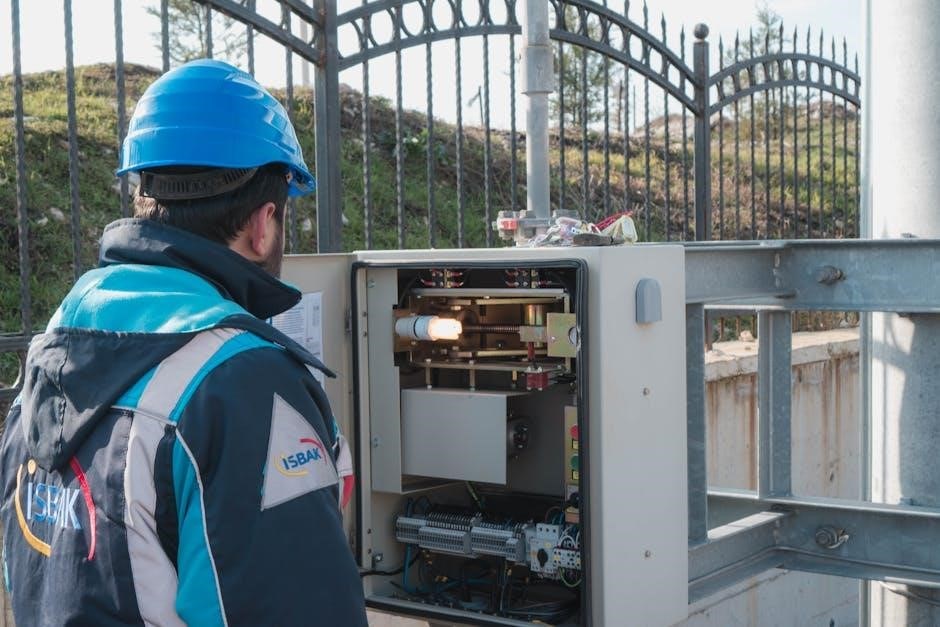
Safety Guidelines for Working with Wiring Diagrams
Always disconnect power before working with wiring diagrams. Use insulated tools, follow safety protocols, and ensure proper grounding to prevent electrical shocks and hazards.
6.1 Precautions Before Starting Work
Before beginning any electrical work, ensure the power supply is completely disconnected. Verify this using a voltage tester to avoid accidental shocks. Wear appropriate PPE, including insulated gloves and safety glasses. Review the wiring diagram thoroughly to understand the circuit layout and identify potential hazards. Ensure all tools are properly insulated and in good condition. Familiarize yourself with emergency procedures, such as knowing the location of the first aid kit and fire extinguisher. Never attempt repairs without proper training or knowledge of electrical systems.
6.2 Safety Tools and Equipment
Essential safety tools include insulated screwdrivers, pliers, and wire cutters to prevent electrical shocks. A multimeter is crucial for measuring voltage, current, and resistance. Thermal imaging cameras detect overheating components. Protective gear like insulated gloves, safety glasses, and a fire extinguisher are mandatory. A non-contact voltage tester ensures circuits are de-energized before work begins. These tools and equipment help prevent accidents, ensuring compliance with safety standards and enabling safe electrical system maintenance and repairs.
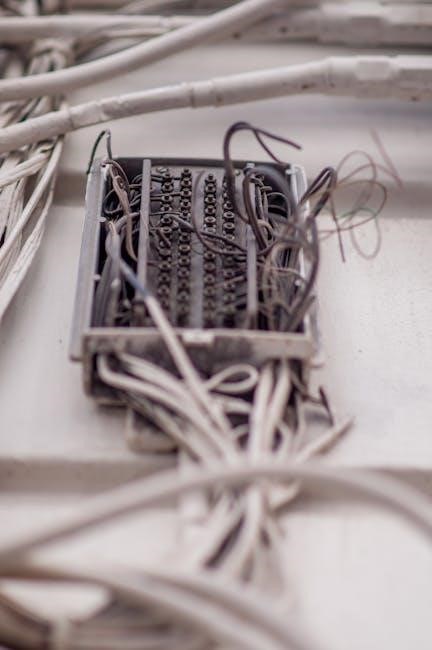
Tools and Software for Creating Wiring Diagrams
CAD software is widely used for designing wiring diagrams, offering precision and scalability. Hand drawing techniques are also employed for simplicity and quick sketches, ensuring clarity and accuracy.
7.1 CAD Software for Wiring Diagrams
CAD software is a powerful tool for creating wiring diagrams, offering precision and scalability. It allows users to design complex electrical systems with ease, using libraries of symbols and templates. Features include automatic routing, error checking, and customization options, ensuring accurate and efficient diagram creation. CAD software is essential for professionals, enabling them to produce detailed, industry-standard wiring diagrams for various applications, from residential to industrial systems. Regular updates and support further enhance its utility in electrical design.
7.2 Hand Drawing Techniques
Hand drawing techniques are a traditional method for creating wiring diagrams, ideal for simple projects or when CAD software is unavailable. Using tools like pens, pencils, and graph paper, technicians can sketch circuits with precision. Templates or stencils for symbols and components enhance accuracy. While time-consuming, hand-drawn diagrams offer a clear, concise visual representation of electrical systems. This method is beneficial for understanding fundamental connections and is often used in educational settings or for quick, on-site modifications. Despite CAD’s prevalence, hand drawing remains a valuable skill for electrical professionals.

Troubleshooting Using Wiring Diagrams
Wiring diagrams are essential for identifying faults in electrical circuits, such as short circuits or open connections. They provide a clear visual path to locate and repair issues efficiently, ensuring system reliability and safety.
8.1 Identifying Faults in the Circuit
Using a wiring diagram, technicians can trace circuit pathways to pinpoint faults like short circuits, open connections, or malfunctioning components. By comparing the diagram with the actual setup, they identify discrepancies, such as incorrect wire colors or loose connections, which indicate potential issues. This systematic approach ensures accurate diagnosis, reducing downtime and enhancing safety during repairs.
8.2 Repairing Electrical Connections
Repairing electrical connections requires careful reference to the wiring diagram to ensure accuracy. Technicians locate the faulty area, verify wire integrity, and secure connections to prevent future issues. Proper tools, such as insulated pliers and screwdrivers, are essential for safe repairs. After fixing, the system is tested to confirm functionality. Adhering to safety protocols and electrical standards ensures reliable and hazard-free connections, minimizing risks of short circuits or malfunctions.

Best Practices for Wiring Diagrams
Adhere to standardized symbols and clear labeling for clarity. Regularly update diagrams to reflect system changes and ensure accuracy. Use color coding for wire identification and maintain neat organization to prevent errors and enhance readability.
9.1 Labeling and Organization
Proper labeling and organization are crucial for wiring diagrams. Each component, such as switches, outlets, and circuits, should be clearly labeled with their functions. Using consistent color codes for wires helps in quick identification. Organizing the diagram hierarchically, starting from the power source to the final loads, ensures logical flow. Including a legend or key explains symbols, making the diagram universally understandable. Regular updates and cross-referencing with system changes maintain accuracy and prevent confusion during installations or repairs, ensuring safety and efficiency in electrical work.
9.2 Updating and Maintaining Diagrams
Regularly updating and maintaining wiring diagrams ensures accuracy and reflects system modifications. Changes in circuitry, new components, or repairs should be documented promptly. Using CAD software simplifies updates, while hand-drawn diagrams require meticulous revisions. Cross-referencing with original designs and field observations prevents errors. Maintaining clear documentation and version control ensures all stakeholders have the latest information. This practice minimizes risks, ensures compliance with safety standards, and optimizes system performance over time, making future troubleshooting and upgrades more efficient and reliable.
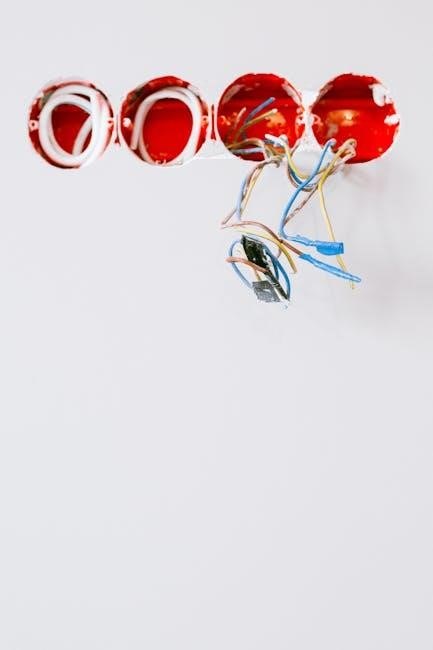
Resources for Learning More
Recommended books like the 101 Electrical Wiring Diagram PDF offer comprehensive guides. Online courses and tutorials provide step-by-step instructions and practical examples for mastering wiring diagrams and electrical systems effectively.
10.1 Recommended Books and Guides
The 101 Electrical Wiring Diagram PDF is a comprehensive guide offering detailed insights into electrical systems. It covers fundamentals, component wiring, and advanced techniques. Electrical Wiring Diagrams Download PDF provides step-by-step instructions for installing and troubleshooting. Electrical 101 Understanding Basic Wiring Diagrams is ideal for beginners, explaining concepts clearly. These resources include color diagrams, practical examples, and safety tips, making them essential for both DIY enthusiasts and professionals working on residential, commercial, or industrial projects.
10.2 Online Courses and Tutorials
Online courses and tutorials provide interactive learning experiences for mastering electrical wiring diagrams. Platforms offer step-by-step guides, video lessons, and practical exercises. Electrical Wiring Diagrams Download PDF courses cover residential, commercial, and industrial systems. PT1 Electrical 101 Understanding Basic Wiring Diagrams is a popular tutorial for beginners. Additionally, websites like Free Automotive Wiring Diagrams offer specialized training for vehicle systems. These resources combine theoretical knowledge with hands-on practice, making them ideal for DIY enthusiasts and professionals alike.
The 101 Electrical Wiring Diagram PDF is a comprehensive guide detailing electrical systems’ components, symbols, and applications. It serves as an essential resource for professionals and DIY enthusiasts, providing clear instructions for safe and efficient electrical work. By bridging theoretical knowledge with practical implementation, the guide ensures that users can navigate complex wiring tasks with confidence. Its detailed diagrams and explanations make it an indispensable tool for anyone working with electrical systems, promoting safety and efficiency in all projects.
